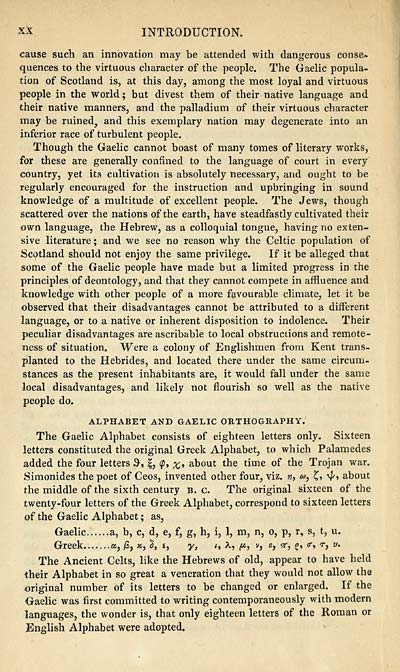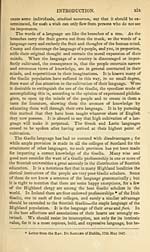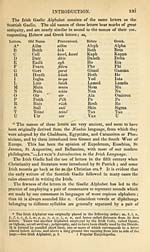Books and other items printed in Gaelic from 1841 to 1870 > Stéidhean a' Ghràmair Ghaëlig
(24) Page xx
Download files
Complete book:
Individual page:
Thumbnail gallery: Grid view | List view

xx
INTRODUCTION.
cause such an innovation may be attended with dangerous conse*
quences to the virtuous character of the people. The Gaelic popula-
tion of Scotland is, at this day, among the most loyal and virtuous
people in the world; but divest them of their native language and
their native manners, and the palladium of their virtuous character
may be ruined, and this exemplary nation may degenerate into an
inferior race of turbulent people.
Though the Gaelic cannot boast of many tomes of literary works,
for these are generally confined to the language of court in every
country, yet its cultivation is absolutely necessary, and ought to be
regularly encouraged for the instruction and upbringing in sound
knowledge of a multitude of excellent people. The Jews, though
scattered over the nations of the earth, have steadfastly cultivated their
own language, the Hebrew, as a colloquial tongue, having no exten-
sive literature; and we see no reason why the Celtic population of
Scotland should not enjoy the same privilege. If it be alleged that
some of the Gaelic people have made but a limited progress in the
principles of deontology, and that they cannot compete in affluence and
knowledge with other people of a more favourable climate, let it be
observed that their disadvantages cannot be attributed to a difFerent
language, or to a native or inherent disposition to indolence. Their
peculiar disadvantages are ascribable to local obstructions and remote-
ness of situation. Were a colony of Englishmen from Kent trans-
planted to the Hebrides, and located there under the same circum-
stances as the present inhabitants are, it would fall under the same
local disadvantages, and likely not flourish so well as the native
people do.
ALPHABET AND GAELIC ORTHOGRAPHY.
The Gaelic Alphabet consists of eighteen letters only. Sixteen
letters constituted the original Greek Alphabet, to which Palamedes
added the four letters g, <p, %, about the time of the Trojan war.
Simonides the poet of Ceos, invented other four, viz. n, co, £, about
the middle of the sixth century b. c. The original sixteen of the
twenty-four letters of the Greek Alphabet, correspond to sixteen letters
of the Gaelic Alphabet ; as,
Gaelic a, b, c, d, e, f, g, h, i, 1, m, n, o, p, r, s, t, u.
Greek a, /3, x, ì, t, y, t, X, p, v, o, <7t, <r, r, v.
The Ancient Celts, like the Hebrews of old, appear to have held
their Alphabet in so great a veneration that they would not allow the
original number of its letters to be changed or enlarged. If the
Gaelic was first committed to writing contemporaneously with modern
languages, the wonder is, that only eighteen letters of the Roman or
English Alphabet were adopted.
INTRODUCTION.
cause such an innovation may be attended with dangerous conse*
quences to the virtuous character of the people. The Gaelic popula-
tion of Scotland is, at this day, among the most loyal and virtuous
people in the world; but divest them of their native language and
their native manners, and the palladium of their virtuous character
may be ruined, and this exemplary nation may degenerate into an
inferior race of turbulent people.
Though the Gaelic cannot boast of many tomes of literary works,
for these are generally confined to the language of court in every
country, yet its cultivation is absolutely necessary, and ought to be
regularly encouraged for the instruction and upbringing in sound
knowledge of a multitude of excellent people. The Jews, though
scattered over the nations of the earth, have steadfastly cultivated their
own language, the Hebrew, as a colloquial tongue, having no exten-
sive literature; and we see no reason why the Celtic population of
Scotland should not enjoy the same privilege. If it be alleged that
some of the Gaelic people have made but a limited progress in the
principles of deontology, and that they cannot compete in affluence and
knowledge with other people of a more favourable climate, let it be
observed that their disadvantages cannot be attributed to a difFerent
language, or to a native or inherent disposition to indolence. Their
peculiar disadvantages are ascribable to local obstructions and remote-
ness of situation. Were a colony of Englishmen from Kent trans-
planted to the Hebrides, and located there under the same circum-
stances as the present inhabitants are, it would fall under the same
local disadvantages, and likely not flourish so well as the native
people do.
ALPHABET AND GAELIC ORTHOGRAPHY.
The Gaelic Alphabet consists of eighteen letters only. Sixteen
letters constituted the original Greek Alphabet, to which Palamedes
added the four letters g, <p, %, about the time of the Trojan war.
Simonides the poet of Ceos, invented other four, viz. n, co, £, about
the middle of the sixth century b. c. The original sixteen of the
twenty-four letters of the Greek Alphabet, correspond to sixteen letters
of the Gaelic Alphabet ; as,
Gaelic a, b, c, d, e, f, g, h, i, 1, m, n, o, p, r, s, t, u.
Greek a, /3, x, ì, t, y, t, X, p, v, o, <7t, <r, r, v.
The Ancient Celts, like the Hebrews of old, appear to have held
their Alphabet in so great a veneration that they would not allow the
original number of its letters to be changed or enlarged. If the
Gaelic was first committed to writing contemporaneously with modern
languages, the wonder is, that only eighteen letters of the Roman or
English Alphabet were adopted.
Set display mode to:
![]() Universal Viewer |
Universal Viewer | ![]() Mirador |
Large image | Transcription
Mirador |
Large image | Transcription
Images and transcriptions on this page, including medium image downloads, may be used under the Creative Commons Attribution 4.0 International Licence unless otherwise stated. ![]()
| Rare items in Gaelic > Books and other items printed in Gaelic from 1841 to 1870 > Stéidhean a' Ghràmair Ghaëlig > (24) Page xx |
|---|
| Permanent URL | https://digital.nls.uk/101711887 |
|---|
| Description | Out-of-copyright books printed in Gaelic between 1631 and 1900. Also some pamphlets and chapbooks. Includes poetry and songs, religious books such as catechisms and hymns, and different editions of the Bible and the Psalms. Also includes the second book ever published in Gaelic in 1631. |
|---|

